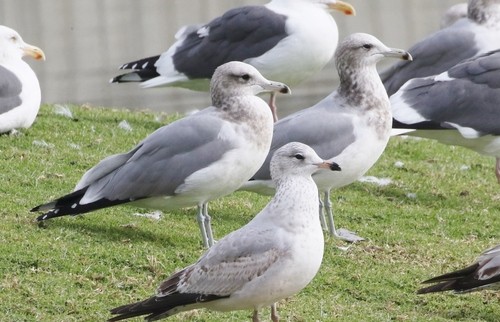California Gull
A species of Gulls Scientific name : Larus californicus Genus : Gulls
California Gull, A species of Gulls
Botanical name: Larus californicus
Genus: Gulls
Content
Description People often ask General Info
 Photo By silversea_starsong , used under CC-BY-NC-4.0 /Cropped and compressed from original
Photo By silversea_starsong , used under CC-BY-NC-4.0 /Cropped and compressed from original Description
Adults are similar in appearance to the herring gull, but have a smaller yellow bill with a black ring, yellow legs, brown eyes and a more rounded head. The body is mainly white with grey back and upper wings. They have black primaries with white tips. Immature birds are also similar in appearance to immature herring gulls, with browner plumage than immature ring-billed gulls. Length can range from 46 to 55 cm (18 to 22 in), the wingspan 122–137 cm (48–54 in) and body mass can vary from 430 to 1,045 g (0.948 to 2.304 lb). 
Size
53-56 cm (21-22 in)
Colors
Black
Gray
White
Life Expectancy
20-24 years
Nest Placement
Ground
Clutch Size
1 - 4 eggs
Number of Broods
23 - 27 days
Nestling Period
3 - 4 days
Feeding Habits
California Gull are omnivorous scavengers consuming a diverse diet including fish, insects, small mammals, eggs, grains, carrion, refuse, and more. They feed on the ground, chase flying insects, snatch prey from water surfaces, and dive for aquatic prey.
Habitat
California Gull typically inhabits lakes, marshes, and inland water bodies in western North America, at altitudes up to 9,000 feet during the breeding season. They favor islands, levees, and salt ponds with scant vegetation and are always close to water, which protects against predators. In non-breeding periods, california Gull migrates to the Pacific coast, utilizing coastal environments such as mudflats, estuaries, and beaches. Throughout the year, california Gull feeds in open spaces, avoiding dense forests, and is adaptable to human-altered landscapes.
Nest Behavior
Both sexes of california Gull participate in nest construction, which takes about one week to complete. Nesting sites are sometimes reused annually, with egg-laying patterns and parental roles shared between the male and female to ensure the well-being of their offspring.
Nest Characteristics
California Gull typically build their nest on the ground, either out in the open or at the base of small shrubs. The construction involves an array of materials like bones, feathers, grasses, and vegetation, forming a nest roughly 11 inches wide. Nests can range from simple ground scrapes to more elaborate structures filled with feathers and vegetation.
Dite type
Aquatic invertebrate eater
People often ask
General Info
Feeding Habits
Bird food type
Sounds
Call
Recording location: United States
Behavior
California Gull display a versatile set of behaviors, adeptly navigating land, air, and water to forage, often utilizing their bills to catch prey like flies or scavenge for a varied diet. These birds exhibit a pattern of resting by standing on one leg or sitting with legs tucked and eyes closed. In their social circles, california Gull maintain a balance between communal living and territorial defense during breeding, signaling ownership through distinct postures, and engaging in aggressive vegetation-biting and disputes when necessary. California Gull establish monogamous pairs by age four, with some bonds persisting across seasons, and engage in unique pre-nesting rituals such as synchronized head tossing and 'choking' displays to strengthen the pair bond.
Distribution Area
Their breeding habitat is lakes and marshes in interior western North America from the Northwest Territories, Canada south to eastern California and Colorado. They nest in colonies, sometimes with other birds. The nest is a shallow depression on the ground lined with vegetation and feathers. The female usually lays 2 or 3 eggs. Both parents take turns feeding their chicks. They are migratory, most moving to the Pacific coast in winter. It is only then that this bird is regularly found in western California. 
Species Status
Not globally threatened.